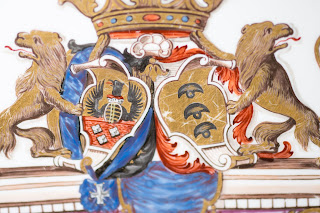
Regarded as the first of the private commission services at Meissen, it is a remarkable piece of ceramic history with a fascinating tale to tell.
 |
Prince Alexander Joseph Sulkowski,
from an 18th century painting
in Leszno city museum.
|
 |
| Augustus II 'The Strong', detail from a 19th century copy of a portrait of circa 1720 by Louis de Silvesre |
What is fascinating is that this very service has been blamed for his descent; it was so much showier & desirable than the King’s own services, and more importantly, he had not asked permission from the King – the owner of the works – before putting in his order. Certainly, he lost favour at the exact same time the pieces began to be delivered, and so Sulkowski lost his many positions of privilege & responsibility to another of Frederick Augustus’s ministers, Heinrich Graf von Brühl. Brühl takes on most of Sulkowski’s titles, including Director of the Meissen works, and straight away commissions his own grand, Baroque service – the delightful & iconic ‘Swan Service’.
 |
| Meissen Sulkowsky Service plate, Rosenberg Collection, Geelong. Sulkowsky Service charger, National Gallery of Victoria, Melbourne. |
The National Gallery already has a magnificent charger from Brühl’s service, and these two marvelous Meissen chargers will soon be housed together in the same cabinet – let's hope they get along, and let past disagreements of their respective owners remain as history!







 There’s ‘rare’ and then there’s ‘supremely rare’. These bottles illustrated here belong to the ‘Supremely Rare’ catagory, particularly the smaller engraved one.
There’s ‘rare’ and then there’s ‘supremely rare’. These bottles illustrated here belong to the ‘Supremely Rare’ catagory, particularly the smaller engraved one. 

































